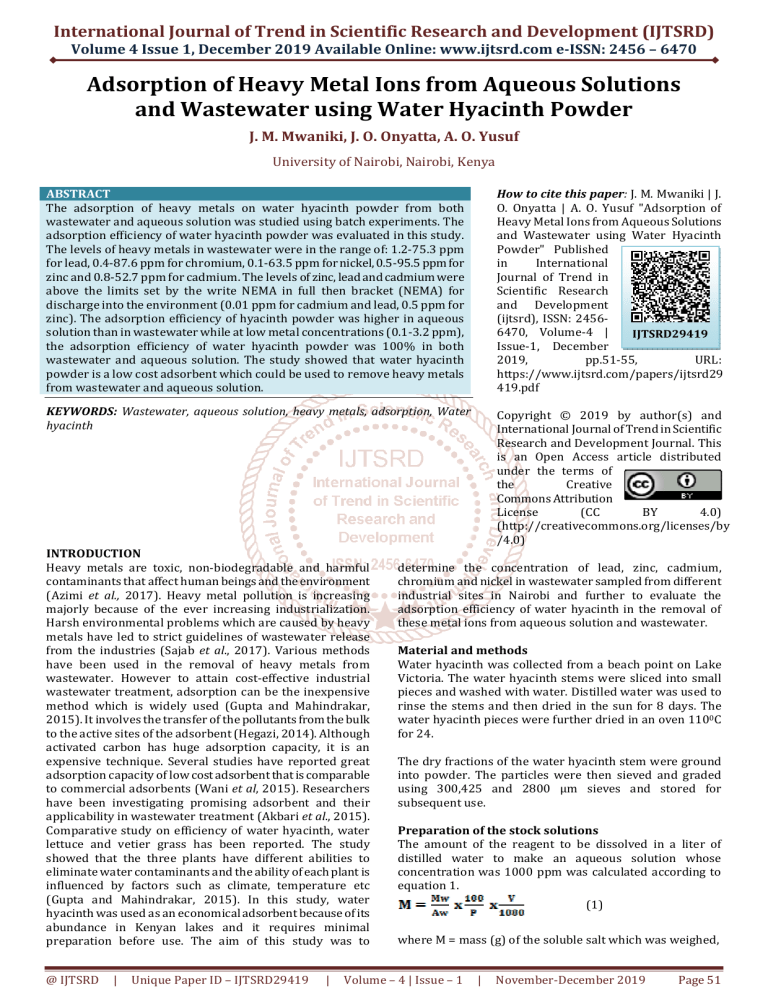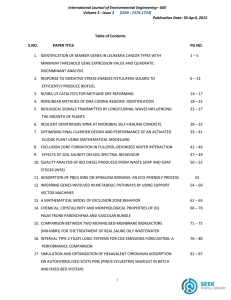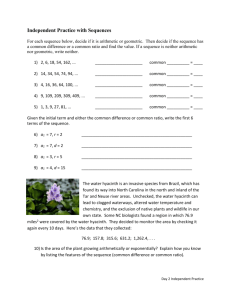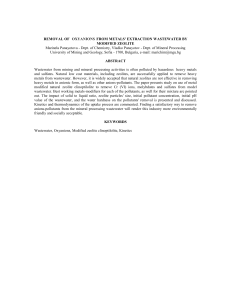
International Journal of Trend in Scientific Research and Development (IJTSRD)
Volume 4 Issue 1, December 2019 Available Online: www.ijtsrd.com e-ISSN: 2456 – 6470
Adsorption of Heavy Metal Ions from Aqueous Solutions
and Wastewater using Water Hyacinth Powder
J. M. Mwaniki, J. O. Onyatta, A. O. Yusuf
University of Nairobi, Nairobi, Kenya
ABSTRACT
The adsorption of heavy metals on water hyacinth powder from both
wastewater and aqueous solution was studied using batch experiments. The
adsorption efficiency of water hyacinth powder was evaluated in this study.
The levels of heavy metals in wastewater were in the range of: 1.2-75.3 ppm
for lead, 0.4-87.6 ppm for chromium, 0.1-63.5 ppm for nickel, 0.5-95.5 ppm for
zinc and 0.8-52.7 ppm for cadmium. The levels of zinc, lead and cadmium were
above the limits set by the write NEMA in full then bracket (NEMA) for
discharge into the environment (0.01 ppm for cadmium and lead, 0.5 ppm for
zinc). The adsorption efficiency of hyacinth powder was higher in aqueous
solution than in wastewater while at low metal concentrations (0.1-3.2 ppm),
the adsorption efficiency of water hyacinth powder was 100% in both
wastewater and aqueous solution. The study showed that water hyacinth
powder is a low cost adsorbent which could be used to remove heavy metals
from wastewater and aqueous solution.
How to cite this paper: J. M. Mwaniki | J.
O. Onyatta | A. O. Yusuf "Adsorption of
Heavy Metal Ions from Aqueous Solutions
and Wastewater using Water Hyacinth
Powder" Published
in
International
Journal of Trend in
Scientific Research
and Development
(ijtsrd), ISSN: 24566470, Volume-4 |
IJTSRD29419
Issue-1, December
2019,
pp.51-55,
URL:
https://www.ijtsrd.com/papers/ijtsrd29
419.pdf
KEYWORDS: Wastewater, aqueous solution, heavy metals, adsorption, Water
hyacinth
Copyright © 2019 by author(s) and
International Journal of Trend in Scientific
Research and Development Journal. This
is an Open Access article distributed
under the terms of
the
Creative
Commons Attribution
License
(CC
BY
4.0)
(http://creativecommons.org/licenses/by
/4.0)
INTRODUCTION
Heavy metals are toxic, non-biodegradable and harmful
contaminants that affect human beings and the environment
(Azimi et al., 2017). Heavy metal pollution is increasing
majorly because of the ever increasing industrialization.
Harsh environmental problems which are caused by heavy
metals have led to strict guidelines of wastewater release
from the industries (Sajab et al., 2017). Various methods
have been used in the removal of heavy metals from
wastewater. However to attain cost-effective industrial
wastewater treatment, adsorption can be the inexpensive
method which is widely used (Gupta and Mahindrakar,
2015). It involves the transfer of the pollutants from the bulk
to the active sites of the adsorbent (Hegazi, 2014). Although
activated carbon has huge adsorption capacity, it is an
expensive technique. Several studies have reported great
adsorption capacity of low cost adsorbent that is comparable
to commercial adsorbents (Wani et al, 2015). Researchers
have been investigating promising adsorbent and their
applicability in wastewater treatment (Akbari et al., 2015).
Comparative study on efficiency of water hyacinth, water
lettuce and vetier grass has been reported. The study
showed that the three plants have different abilities to
eliminate water contaminants and the ability of each plant is
influenced by factors such as climate, temperature etc
(Gupta and Mahindrakar, 2015). In this study, water
hyacinth was used as an economical adsorbent because of its
abundance in Kenyan lakes and it requires minimal
preparation before use. The aim of this study was to
@ IJTSRD
|
Unique Paper ID – IJTSRD29419
|
determine the concentration of lead, zinc, cadmium,
chromium and nickel in wastewater sampled from different
industrial sites in Nairobi and further to evaluate the
adsorption efficiency of water hyacinth in the removal of
these metal ions from aqueous solution and wastewater.
Material and methods
Water hyacinth was collected from a beach point on Lake
Victoria. The water hyacinth stems were sliced into small
pieces and washed with water. Distilled water was used to
rinse the stems and then dried in the sun for 8 days. The
water hyacinth pieces were further dried in an oven 1100C
for 24.
The dry fractions of the water hyacinth stem were ground
into powder. The particles were then sieved and graded
using 300,425 and 2800 µm sieves and stored for
subsequent use.
Preparation of the stock solutions
The amount of the reagent to be dissolved in a liter of
distilled water to make an aqueous solution whose
concentration was 1000 ppm was calculated according to
equation 1.
(1)
where M = mass (g) of the soluble salt which was weighed,
Volume – 4 | Issue – 1
|
November-December 2019
Page 51
International Journal of Trend in Scientific Research and Development (IJTSRD) @ www.ijtsrd.com eISSN: 2456-6470
MW = molecular weight of the salt,
Aw = Atomic mass of the element of interest, V= volume of
the stock solution to be made, P= percentage purity of the
salt. The calculated amount of metal salt which was weighed
is shown in Table1.
Table 1 Amount of salts weighed (g) to make aqueous
solution whose concentration was 1000 ppm.
Metal
MF
MW
Amt (g)
Pb
Pb (NO3)2
331.2
1.6311
Zn
Zn (NO3)2. 6H2O 297.48 4.7396
Cd
3CdSO4.8H2O
769.56 6.9861
Cr
Cr(NO3)3.9H2O 400.15 7.9347
Ni
Ni (NO3). 6H20 290.80 5.0560
MF = Molecular formula, MW = molecular wt
Amt = Amount weighed (g)
The amount weighed was then placed in a 1000 ml
volumetric flask. 100 ml of distilled water was added and
stirred. 30 ml of 1M HNO3 was added and the solution was
swirled. Distilled water was added to the mark.
The working standards for the AAS were obtained from
standard commercial solution by dilution. 0.1M HNO3 and
0.1M NaOH were used to adjust the pH of the stock solutions.
Collection of the wastewater samples
Samples of wastewater were collected from Sites A (Battery
manufacturing Company), Site B (Paints manufacturing
Company), Site C (Steel manufacturing Company) and Site D
(Plastics manufacturing Company) in industrial area in
Nairobi County. Sampling was done using pre-cleaned
polyethylene bottles that had been washed with distilled
water and rinsed with HNO3 and labeled. The samples were
then stored in a refrigerator for subsequent analysis.
Digestion of wastewater samples
300 ml of the wastewater samples were first treated with 3
ml dilute nitric acid, shaken thoroughly and allowed to stand
for 24 hrs. The samples were gravity filtered using
Whatmann paper (No. 40). The filtrate was shaken well
before taking 100 ml which was added to a beaker using a
100ml volumetric flask. To the 100 ml sample, 3.0 ml of
acquaregia was added. The resulting mixture was covered
using a watch glass.
A blank was also prepared by adding 100 ml of deionized
water into a beaker, followed by 3.0 ml of acquaregia and
covering the beaker with a watch glass. The samples were
heated at 900 C for 3 hrs in a fume hood until the volume of
the sample was reduced to 20 ml. The samples were allowed
to stand for 30 minutes to cool. The watch glass was
removed and the sample was dispensed to a 100 ml
volumetric flask. Deionized water was added to the samples
to make it to 100 ml. The sample was stirred for 5 minute,
filtered and the filtrate was used for the determination of
heavy metal concentration using AAS.
Determination of heavy metals in the samples using AAS
The standards were then run in the instrument, read and a
linear calibration curve for each metal was obtained. The
samples were then run in AAS and concentration of heavy
metals obtained from linear line.
Removal of heavy metals from wastewater
100 ml of digested sample was added to 0.5g of powdered
water hyacinth contained in a series of beakers. The
mixtures were stirred continuously for 5 minutes. The
samples were allowed to stand for 2 hours for adsorption to
occur. The mixtures were filtered and the residual
concentration (C2) of the selected heavy metal ions
contained in the filtrate established using the AAS. The
adsorption efficiency of water hyacinth in the removal of
selected metallic ions from wastewater was computed using
Equation (2)
(2)
Where q- adsorption efficiency of water hyacinth, C1concentration of the selected heavy metals in wastewater;
C2-residual concentration of the selected heavy metals after
adsorption
Removal of heavy metals from aqueous solution using
water hyacinth
The experiments were carried out using 100 ml of aqueous
solutions whose metal concentrations varied from 75.3 ppm
for lead, 52.7 ppm for cadmium, 95.5 ppm for zinc, 63.6 ppm
for nickel and 87.6 ppm for chromium. Each of the metal
concentrations was added to 0.5g (<300 μm) of powdered
water hyacinth contained in a series of 500 ml beakers. The
mixtures were stirred continuously for 5 minutes and
allowed to stand for 2 hours for adsorption to occur.
The mixture was filtered and the concentrations (C2) of
selected heavy metal ions were determined in the filtrate
using AAS. The adsorption efficiency of water hyacinth in the
removal of selected metallic ions from wastewater was
computed using Equation (2).
Results and discussion
Concentration of Heavy metals in wastewater
The concentration of the heavy metals in the wastewater
samples at sites A, B, C, and D are shown in Table 2.
Table2. Concentration (mg/l) of heavy metals in wastewater
Heavy metal concentration (mg/l)
Site
Pb
Cd
Zn
Ni
Cr
A
68.5 ± 0.1 52.7 ± 0.1 0.75 ± 0.01 0.2 ± 0.02 0.51 ± 0.01
B
75.3± 0.2 40.0 ± 0.5 95.5 ± 0.2 0.14 ± 0.06 0.51 ± 0.01
C
1.2 ± 0.03 0.98 ± 0.1 48.8 ± 0.3
63.5 ± 0.2
87.6 ± 0.5
D
3.2 ± 0.01 0.88 ± 0.6 0.58 ± 0.02 0.11 ± 0.03 0.38 ± 0.01
Site A had very high levels of Pb and Cd. The high
concentration of cadmium could be attributed to the use of
Cadmium Oxide as a conductor in the manufacture of battery
(Klein and Costa, 2007). Lead levels were high because of the
@ IJTSRD
|
Unique Paper ID – IJTSRD29419
|
use of lead metal and lead oxide as electrodes during
manufacturing of batteries (Saaidia et al., 2017). The high
zinc concentration in sites B and C could be attributed to the
use of ZnO and ZnCrO4 as pigments in the manufacture of
Volume – 4 | Issue – 1
|
November-December 2019
Page 52
International Journal of Trend in Scientific Research and Development (IJTSRD) @ www.ijtsrd.com eISSN: 2456-6470
white and yellow paints respectively (Osmond, 2012). High
Pb concentration in Sites A and B could be ascribed to the
use of Pb(CO3)2 and PbCrO4 in paints (Kessler, 2014). The
high concentration of Cadmium in sites A and B could be due
to the use of cadmium sulfide as a pigment in the
manufacture of the yellow paints (Ogilo et al., 2017). The
high concentration of chromium in sites B and C could be
attributed to the use of Cr2O3 and Cr2O3.H2O as a colorant in
chrome green paints (Sabty-Daily, 2017). The high levels of
Cr in site C could be as a result of chromium used in steel
manufacturing (Nakamura et al., 2017). The high nickel
concentration in site C could be attributed to the use of
nickel in the manufacture of steel (Abdallah et al., 2017).
Figure 3 shows the efficiency of water hyacinth in the
removal of heavy metals from wastewater collected from site
C. Again similar trend was observed.
Efficiency of water hyacinth powder in the removal of
heavy metals from wastewater
The effects of powdered water hyacinth (<300 μm) on the
removal of heavy metals in wastewater were investigated
and the results are shown in Figures 1-4
Figure 3: The effects of powdered water hyacinth (<300
μm) on the concentration of heavy metals in waste-water
collected from site C (Steel manufacturing Company).
Figure 4 shows the efficiency of water hyacinth in the
removal of heavy metals from wastewater collected from site
D.
Figure 1: The effects of powdered water hyacinth on the
concentration of heavy metals in wastewater collected
from site A (Battery manufacturing Company)
Heavy metals with high concentration had lower percent
efficiency of removal (Figure 1). This can be ascribed to the
competition for the adsorption sites from other metals in the
wastewater (Medellin-Castillo et al, 2017). This further
confirms the effectiveness of water hyacinth powder in the
removal of heavy metals in wastewater at low
concentrations. Figure 2 shows the efficiency of water
hyacinth in the removal of heavy metals from wastewater
collected from site B. The trend is also the same as Figure 1.
Figure 4: The effects of powdered water hyacinth (<300
μm) on the concentration of heavy metals in waste-water
collected from site D (Plastic manufacturing Company).
Adsorption of heavy metals on adsorbent in an aqueous
solution
The adsorption studies for heavy metals from an aqueous
solution was carried out using the highest concentration for
each metal based on the levels that had been determined in
the wastewater for the various industrial sites (75.3 ppm for
lead, 52.7 ppm for cadmium, 95.5 ppm for zinc, 63.6 ppm for
nickel and 87.6 ppm for chromium) as shown in Table 2. The
results were used to investigate the percentage efficiency of
heavy metal elimination from the aqueous solution by water
hyacinth powder as shown in Figure 5.
Figure 2: The effects of powdered water hyacinth (<300
μm) on the concentration of heavy metals in waste-water
collected from site B (Paints manufacturing Company)
@ IJTSRD
|
Unique Paper ID – IJTSRD29419
|
Volume – 4 | Issue – 1
|
November-December 2019
Page 53
International Journal of Trend in Scientific Research and Development (IJTSRD) @ www.ijtsrd.com eISSN: 2456-6470
Zinc Oxide; ZnCrO4: Zinc Chromate; Pb: Lead; Pb(CO3)2: Lead
Carbonate; PbCrO4: Lead (II) Chromate; Cr2O3:Chromium
(III) Oxide; Cr2O3.H2O Chromium (III) Oxide hydrate; Cd:
Cadmium; Cr: Chromium, Zn: Zinc; Ni: Nickel
Acknowledgements
The authors would like to acknowledge the support from the
Department of Chemistry, University of Nairobi.
Funding
None of the authors received any fund from any person or
organization society
Availability of data and materials
Not applicable
Figure 5: Efficiency of water hyacinth powder in the
removal of heavy metals from aqueous solution.
In the studies where percent efficiency of removal of the
heavy metals was calculated for the wastewater (Figures 1 to
4), heavy metals with low concentrations had the highest %
efficiency removal however in the aqueous solution where
individual metal concentrations existed on their own, the
removal trend was different (Table 3)
Table 3: Efficiency of water hyacinth powder in the
removal of heavy metals from both wastewater and
aqueous solution
% Efficiency of Heavy metal removal
aqueous
Heavy metal
wastewater
solution
Nickel (63.6 mg/l)
65.8
60.4
Zinc (95.5 mg/l)
78.7
74.9
Cadmium (52.7 mg/l)
76.9
68.9
Lead (75.3 mg/l)
81.1
71.0
Chromium (87.6 ppm)
73.1
70.2
The study showed that the percent efficiency in the removal
of the heavy metal ions was higher in aqueous solution than
in the wastewater irrespective of the concentration used.
This could be attributed to external competition for the
adsorption sites from other metal ions in the wastewater
(Park et al., 2015).
Conclusion
The study showed that the levels of zinc, lead and cadmium
in wastewater were above the limit recommended by NEMA.
The percent efficiency to remove heavy metals from both
wastewater and aqueous solutions by water hyacinth
powder at low concentrations of heavy metal was higher
than at high concentration. Hence, water hyacinth
E.crassipes) can be used to remove heavy metals in
wastewater released from the industries. The adsorption
efficiency in aqueous solution was higher than the
adsorption efficiency in wastewater. Cd and Pb
concentrations in sites A, B were very high; Zn in B, and C
were very high; Ni in C was very high; Cr in B and C were
very high.
Abbreviations
NEMA: National Environment Management Authority; AAS:
Atomic Absorption Spectrophotomer; HNO3: Nitric acid;
NaOH: Sodium hydroxide; pH: potential hydrogen; ppm:
parts per million; M: Molarity; Mg/l: milligram per liter; ZnO:
@ IJTSRD
|
Unique Paper ID – IJTSRD29419
|
Authors’ contribution
John Onam Onyatta and Amir Okeyo Yusuf designed the
experiment. Joseph Munene Mwaniki collected the samples,
carried out sample preparation, analysis and wrote the
manuscript. John Onam Onyatta and Amir Okeyo Yusuf
revised the manuscript critically for intellectual content.
Competing interests
The author declares that they have no competing interest.
References
[1] Abdallah, M., Jahdaly, B.A.A, Salem, M. M., Fawzy, A. and
Abdel, F.A.A. (2017) Pitting corrosion of Nickel and
stainless steel in chloride solutions and inhibition using
inorganic
compounds.
JMES
8:2599-2607
doi:http://www.jmaterenvironsci.com/
[2] Akbari, M Hallajisani, A., Keshtkar, A. R., Shahbeig, H.,
and Ghorbanian, S.A. (2015).Equilibrium and Kinetic
study and modeling of Cu(II)and Co(II) synergistic
biosorption from Cu(II)-Co(II) single and binary
mixtures
of
brown
algae
C.indica.
J.Environ.Chem.Eng.3:140-149
doi.org/10.1016/j.jece.2014.11.004
[3] Azimi, A., Azari, A., Rezakazemi, M. and Ansarpour, M.
(2017) Removal of heavy metals from industrial waste
water:
A
review.
ChemBioEng1:1-24
doi:
10.1002/cben.201600010
[4] Gupta, P., Roy, S. and Mahindrakar, A. (2015) Removal
of heavy metals from waste water using water
hyacinth,Water Lettuce and Vetiver Grass. A Review.
IJEEM 7:11-34 doi: 10.5923/j.re.20120205.04
[5] Hegazi, H.A.(2013). Removal of the characteristics of
heavy metal from waste-water by low-cost adsorbents.
HBRC
Journal
9(3):276-282.
http://ees.elsevier.com/hbrcj
[6] Kessler, R. (2014) Lead based decorative paints: Where
are they still sold and why? Environ. Health Perspect.
122(4): 96-103 doi: 10.1289/ehp.122-A96
[7] Klein, C., and Costa, M. (2007). Nickel. In G.F. Nordberg,
B.A. Fowler, M. Nordberg, &L. Friberg (EDS.),
Handbook on toxicology of metals (3rd ed., pp. 743758). Academic Press Inc.
[8] Medellin-Castillo, N.A., Padilla-Ortega, E., Regelesmartinez, M.C, Ocampo-Perez, R., Leyva-Ramos, R. and
Carranza-Alvarez, C. (2017) Single and competetive
adsorption of Cd(II) and Pb(II) ions from aqueous
Volume – 4 | Issue – 1
|
November-December 2019
Page 54
International Journal of Trend in Scientific Research and Development (IJTSRD) @ www.ijtsrd.com eISSN: 2456-6470
solution onto industrial chili seeds (Capscum annum)
waste.
Sustain.
Environ.
Res.
27(3):61-69
doi 10.1016/j.serj.2017.01.004
[13] J Environ Sci Health A Tox Hazard Subst Environ Eng.
50(11):1194-1204
doi: 10.1080/10934529.2015.1047680.
[9] Nakamura, S., Kondo, Y., Nakajima, K., Ohno, H. and
Pauliuk, S.(2017) Quantifying recycling and losses of Cr
and Ni in steel throughout multiple life cycles using
MaTrace-Alloy. Environ sci techn. 51(17):9469-9476
doi: 10.1021/acs.est.7b01683
[14] Saaidia, S., Delimi, R., Benredjem, Z., Mehellou, A.,
Djemel, A. and Barbari, K. (2017) Use of a PbO2
electrode of lead-acid battery for the electrochemical
degradation of methylene blue Sep Sci Technol
52(9):1602-1614
https://doi.org/10.1080/01496395.2017.1291681
[10] Ogilo, J.K., Onditi, A.O., Salim, A.M. and Yusuf, A.O.
(2017) Assessment of levels of heavy metals in paints
from interior walls and indoor dust from residential
houses in Nairobi City County, Kenya. Chemical Science
Journal 21:1-7 DOI:10.9734/CSJI/2017/37392
[11] Osmond, G (2012). Zinc white: A review of zinc oxide
pigment properties and implications for the stability in
oil
based
paintings.
AICCM
33(1):20-29
https://doi.org/10.1179/bac.2012.33.1.004
[12] Park, J. H., Cho, J.S., Ok, Y. S., Kim, S. H., Kang, S.W., Choi,
I. K., Heo, J. S., Delaune, R. D. and Seo , D. C. (2015)
Competitive adsorption and selectivity sequence of
heavy metals by chicken bone-derived biochar: Batch
and column experiment.
@ IJTSRD
|
Unique Paper ID – IJTSRD29419
|
[15] Sabty-Daily, R. A., Harris, P. A., Hinds, W. C. and Froines,
J.R. (2017). Size distribution and speciation of
chromium in paints spray aerosols at an aerospace
facility.
Ann
Occup
Hyg
49(1):47-59
doi:10.1093/annhyg/meh081
[16] Sajab, M. S., Chia, H. C., Zakaria, S. and Sillanpaa, M.
(2017). Adsorption of heavy metals ions on surface of
functionalized oil palm empty fruit bunch fibers: Single
and Binary systems Sian Malaysiana 46(1):157-165.
http://dx.doi.org/10.17576/jsm-2017-4601-20
[17] Wani, A. L., Ara, A., and Usmani J. A. (2015) Lead
toxicity: A preview. Interdiscip Toxicol. 8(2):55-64
doi: 10.1515/intox-2015-0009
Volume – 4 | Issue – 1
|
November-December 2019
Page 55






